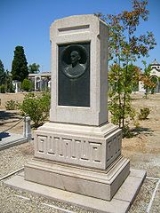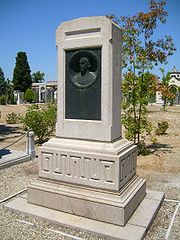
Adelchi Negri
Encyclopedia
Adelchi Negri was an Italian
pathologist and microbiologist
who was born in Perugia
. He studied medicine and surgery
at the University of Pavia
, where he was a pupil of Camillo Golgi
(1843–1926). After graduation in 1900, he became an assistant to Golgi at his pathological institute. In 1909 Negri became a professor of bacteriology
, and the first official instructor of bacteriology in Pavia
. On February 19, 1912 he died of tuberculosis
at age 35.
Negri performed extensive research in the fields of histology
, hematology
, cytology
, protozoology
and hygiene
. In 1903 he discovered the eponymous Negri bodies
, which are cytoplasm
atic inclusion bodies located in the Purkinje cells of the cerebral cortex
in cases of rabies
in animals and humans. At the time Negri mistakenly described the pathological agent of rabies as a parasitic protozoa
. A few months later, Paul Remlinger (1871–1964) at the Constantinople Imperial Bacteriology Institute correctly demonstrated that the aetiological
agent of rabies was not a protozoon, but a filterable virus
.
Negri went on, however, to demonstrate in 1906 that the smallpox vaccine then known as "vaccine virus", or "variola vaccinae", was also a filterable virus

and his teacher, the Nobel Prize winning Camillo Golgi.
Italy
Italy , officially the Italian Republic languages]] under the European Charter for Regional or Minority Languages. In each of these, Italy's official name is as follows:;;;;;;;;), is a unitary parliamentary republic in South-Central Europe. To the north it borders France, Switzerland, Austria and...
pathologist and microbiologist
Microbiologist
A microbiologist is a scientist who works in the field of microbiology. Microbiologists study organisms called microbes. Microbes can take the form of bacteria, viruses, fungi, and protists...
who was born in Perugia
Perugia
Perugia is the capital city of the region of Umbria in central Italy, near the River Tiber, and the capital of the province of Perugia. The city is located about north of Rome. It covers a high hilltop and part of the valleys around the area....
. He studied medicine and surgery
Surgery
Surgery is an ancient medical specialty that uses operative manual and instrumental techniques on a patient to investigate and/or treat a pathological condition such as disease or injury, or to help improve bodily function or appearance.An act of performing surgery may be called a surgical...
at the University of Pavia
University of Pavia
The University of Pavia is a university located in Pavia, Lombardy, Italy. It was founded in 1361 and is organized in 9 Faculties.-History:...
, where he was a pupil of Camillo Golgi
Camillo Golgi
Camillo Golgi was an Italian physician, pathologist, scientist, and Nobel laureate.-Biography:Camillo Golgi was born in the village of Corteno, Lombardy, then part of the Austrian Empire. The village is now named Corteno Golgi in his honour. His father was a physician and district medical officer...
(1843–1926). After graduation in 1900, he became an assistant to Golgi at his pathological institute. In 1909 Negri became a professor of bacteriology
Bacteriology
Bacteriology is the study of bacteria. This subdivision of microbiology involves the identification, classification, and characterization of bacterial species...
, and the first official instructor of bacteriology in Pavia
Pavia
Pavia , the ancient Ticinum, is a town and comune of south-western Lombardy, northern Italy, 35 km south of Milan on the lower Ticino river near its confluence with the Po. It is the capital of the province of Pavia. It has a population of c. 71,000...
. On February 19, 1912 he died of tuberculosis
Tuberculosis
Tuberculosis, MTB, or TB is a common, and in many cases lethal, infectious disease caused by various strains of mycobacteria, usually Mycobacterium tuberculosis. Tuberculosis usually attacks the lungs but can also affect other parts of the body...
at age 35.
Negri performed extensive research in the fields of histology
Histology
Histology is the study of the microscopic anatomy of cells and tissues of plants and animals. It is performed by examining cells and tissues commonly by sectioning and staining; followed by examination under a light microscope or electron microscope...
, hematology
Hematology
Hematology, also spelled haematology , is the branch of biology physiology, internal medicine, pathology, clinical laboratory work, and pediatrics that is concerned with the study of blood, the blood-forming organs, and blood diseases...
, cytology
Cell biology
Cell biology is a scientific discipline that studies cells – their physiological properties, their structure, the organelles they contain, interactions with their environment, their life cycle, division and death. This is done both on a microscopic and molecular level...
, protozoology
Protozoology
Protozoology is the study of protozoa, the "animal-like" protists. This term has become dated as our understanding of the evolutionary relationships of the eukaryota has improved....
and hygiene
Hygiene
Hygiene refers to the set of practices perceived by a community to be associated with the preservation of health and healthy living. While in modern medical sciences there is a set of standards of hygiene recommended for different situations, what is considered hygienic or not can vary between...
. In 1903 he discovered the eponymous Negri bodies
Negri bodies
Negri bodies are eosinophilic, sharply outlined, pathognomonic inclusion bodies found in the cytoplasm of certain nerve cells containing the virus of rabies, especially in Ammon's horn of the hippocampus. Often also found in the cerebellar cortex of postmortem brain samples of rabies victims.They...
, which are cytoplasm
Cytoplasm
The cytoplasm is a small gel-like substance residing between the cell membrane holding all the cell's internal sub-structures , except for the nucleus. All the contents of the cells of prokaryote organisms are contained within the cytoplasm...
atic inclusion bodies located in the Purkinje cells of the cerebral cortex
Cerebral cortex
The cerebral cortex is a sheet of neural tissue that is outermost to the cerebrum of the mammalian brain. It plays a key role in memory, attention, perceptual awareness, thought, language, and consciousness. It is constituted of up to six horizontal layers, each of which has a different...
in cases of rabies
Rabies
Rabies is a viral disease that causes acute encephalitis in warm-blooded animals. It is zoonotic , most commonly by a bite from an infected animal. For a human, rabies is almost invariably fatal if post-exposure prophylaxis is not administered prior to the onset of severe symptoms...
in animals and humans. At the time Negri mistakenly described the pathological agent of rabies as a parasitic protozoa
Protozoa
Protozoa are a diverse group of single-cells eukaryotic organisms, many of which are motile. Throughout history, protozoa have been defined as single-cell protists with animal-like behavior, e.g., movement...
. A few months later, Paul Remlinger (1871–1964) at the Constantinople Imperial Bacteriology Institute correctly demonstrated that the aetiological
Etiology
Etiology is the study of causation, or origination. The word is derived from the Greek , aitiologia, "giving a reason for" ....
agent of rabies was not a protozoon, but a filterable virus
Virus
A virus is a small infectious agent that can replicate only inside the living cells of organisms. Viruses infect all types of organisms, from animals and plants to bacteria and archaea...
.
Negri went on, however, to demonstrate in 1906 that the smallpox vaccine then known as "vaccine virus", or "variola vaccinae", was also a filterable virus

Tomb
Negri was buried in the Monumental Cemetery of Pavia (Viale San Giovannino), along the central lane, on the left, near the tombs of other two important medical scientists, the anatomist Bartolomeo PanizzaBartolomeo Panizza
Bartolomeo Panizza was an Italian anatomist born in Vicenza.He received a medical degree in surgery from Padua, and furthered his studies at Bologna and Pavia. In 1809 he became a professor at the University of Pavia, and in 1835 a member of the Academia nazionale delle scienze...
and his teacher, the Nobel Prize winning Camillo Golgi.

